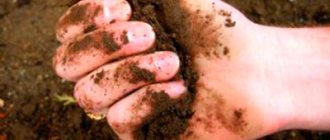Many companies can determine the level of groundwater, but it is not cheap. If you are just choosing a site, it makes no sense to take a team with you every time. How to detect high groundwater yourself without much expense?
In the ideal scenario of buying a house or land, the previous owner hands you a map of groundwater along with the documents, and you know exactly what is happening underground on the coveted acres. Unfortunately, in reality this rarely happens. The services of surveyors are now expensive and therefore many people prefer to do without them.
However, it is impossible to build a house, install fence posts, dig a well, or even simply plant bushes and trees without knowledge of the depth of groundwater. And why do you need a plot where you can’t install anything larger than a toilet, and only reeds and mosquitoes grow well?
Before you begin active development of the territory, use several simple methods that will allow you to find out how deep the groundwater lies on the site and, based on this, choose the type of foundation, plant varieties, or even refuse to acquire the territory.
It is necessary to check the depth of groundwater in the spring, after the snow has melted, or in late autumn, when the heavy rains have passed. In hot summers or frosty winters, the groundwater level will be minimal, and measurements will not give an accurate picture.
Inspection of vegetation on the site
An experienced gardener can determine at first glance at the site whether there is groundwater near the surface of the earth. If the area is already planted, then pay attention to the presence and condition of mature trees. Large apple trees, for example, will not be able to survive with surface water; they will simply “choke.”
If the land plot is still empty, the following list of “settlers” should alert you:
- cattail (distance from surface to water less than 1 m);
- reed, horsetail, willow, alder, meadowsweet (from 1.5 to 3 m);
- wormwood, licorice (up to 5 m).
Plants tilted to one side, but not growing next to each other, can also indicate that water is close. However, this may also be a sign of strong winds, so you should not rely only on this sign.
Plants
Plants will tell you
Plants serve as a good natural indicator of the depth of the upper layer of groundwater. In order to use this method, it is important that the area has already been fallow for some time. This period will provide an opportunity for vegetation to occupy its niche. You should pay attention to:
- Reed. If it is in an area that is allocated for development, then, most likely, the layer is located at a depth of 1 to 3 m.
- Rogoz. It is a tall marsh grass. Often used for weaving various utensils. This view indicates that the liquid is approximately 1 m away.
- Wormwood is a member of the Asteraceae. If it grows rapidly, then the limits of the aquifer are from 3 to 5 m. Buildings can be freely built on such an area.
- Licorice is capable of spreading its root system to a depth of up to 5 m. Usually it indicates that the upper threshold of water can reach 1.5 meters.
- Blackberries, raspberries - perched grass can reach 60 cm in a specific area.
- Gooseberries, currants and sea buckthorn are indicators of the occurrence of perched water at a level of 1 m from the surface.
- If apple and pear trees have been growing on the site for more than one year, then you can be calm: the water is at a level of 2 meters or more. The fact is that otherwise such trees cannot withstand a longer stay with a smaller layer of water. As the root system grows, there is a greater consumption of oxygen, which turns out to be insufficient, and the plant simply withers.
- Cherries and plums will require water at a level of more than 1.5 meters.
In the case where the site was cleared before purchase, then you can ask the old-timers about the vegetation and their experience in construction work.
Inspection of nearby wells
Another quick way to find out how close groundwater is is to get to know your neighbors. Find a residential building nearby, preferably not a new building, and ask the owners a question. Over the years of living in this territory, they have learned for sure whether this problem exists here and will probably agree to show you a well or tell you about the presence of water in the cellar in the spring.
By the way, in areas where foundation work has just begun, so-called “technical wells” are most often made for construction needs. The water mirror is also clearly visible in them.
Other methods of determination
One simple way is to contact the land management service, where they can provide specific data or at least topographic maps that can be used to determine the highlands and lowlands. By the way, you can make independent observations in this regard. Look around and assess whether the area is on a hill or in a valley. The lower the level, the more likely it is that groundwater will be close.
Can be determined by the water level in the well
If there is a well nearby, the level can be approximately estimated from it. To do this, just look into the middle, lower the measuring cord to the surface of the water, then measure the distance. But the value will be approximate if the source is filled with an underground river, which, due to the flow, can slightly raise this value. Also, this will not indicate the saturation of the soil specifically in your area.
Observation of animals and insects
A clear sign of a waterlogged area is the presence of mosquitoes, frogs, snails or slugs. If the number of these creatures is clearly higher than normal, problems with excess water will not keep you waiting. Carefully inspect the soil: if there are no mouse holes or anthills in the area, it means that the water is located very close to the surface.
They say that places where groundwater accumulates are loved by cats and avoided by dogs, but this knowledge can hardly be applied to an empty area and in a short time.
There is also an old way of detecting water underground, however, you will have to look for everything you need to check. Remove the top layer of turf from the ground, place a piece of wool on the ground, a fresh chicken egg on top and cover this structure with a clay pot. In the morning, remove the pot and inspect the egg and wool: if there is dew on the egg, then groundwater is close, if only on the wool, it is 2-3 meters away, and if everything is dry, then there is no water nearby.
A high groundwater level is not an obstacle to a high-quality foundation
Groundwater research
As a rule, when the water is close to the surface, and the heavy structure of the future house does not allow the use of a columnar foundation, a shallow strip foundation (MSLF), or a floating one, “helps out.” It is installed quite simply in dry pits/trenches. After a trench with a depth of 70-80 cm and a width of at least 50 cm is ready, it is covered with geotextiles, which will prevent mixing of the soil and bedding. After this, you can begin installing the wooden formwork.
Upon completion of installation, it is necessary to create a sand cushion at least 20 cm thick at the bottom of the trench, compact it well and cover it with a layer of crushed stone of similar thickness. This will eliminate the possibility of water rising by capillary action and damage to concrete by groundwater or frost heaving forces. It is worth knowing that the sand cushion should be compacted in a damp (not wet) state - only then will it be as useful as possible.
After this, it is necessary to carry out work on waterproofing the formwork and the underlying cushion. This will prevent cement lait from seeping through loosely fitted formwork boards. Subsequently, a frame made of reinforcement (diameter 10-12 mm) and reinforcing mesh is installed inside the insulated formwork. After this, you can begin pouring concrete. An important point in the construction of a monolithic foundation is the need to pour it at a time, which makes household concrete mixers “of little use.” It makes sense to order concrete in advance from a construction company.
Drilling test wells
The simplest and most demonstrative method is drilling wells. Moreover, this needs to be done at several points on the site, because groundwater is distributed unevenly. Take a regular garden drill and use it to make 4-5 holes 2-3 meters deep. Check them for water over the next few days. If the bottom of the wells remains dry, then you can safely lay the foundation for a building, make an underground floor or a hole in the garage. But if they are filled with water, then you will have to look for alternative construction options.
Level determination
Before any work on the site, you should find out what the depth of the water is; this can be done independently, even without using special technical devices.
Worth remembering! Any of the above methods should be used at a time when the groundwater level is maximum - the period after the snow melts.
Observation
One of the methods for finding out the groundwater level in any area is to observe the vegetation. In particular, the grass is of interest; if it is green and lush even during the dry periods of summer, then this indicates a high level. This is also indicated by the foggy haze over the area.
Another thing is that these are plants that grow well on the site; if they are moisture-loving and at the same time grow wildly, then this speaks for itself.
Such indicator plants include:
- Reeds – occurrence from 1 to 3 meters.
- Wormwood - if it grows rapidly and occupies large areas - this indicates a groundwater level of 3-5 m.
- Nettle – water at a level of 2-3 meters.
- Currants, sea buckthorn, gooseberries - 1-2 meters.
- Willow loves water very much, so if it grows on the site, this indicates a level of less than 1 meter.
Important! These methods will not provide an accurate determination of groundwater level, but will allow one to determine the approximate condition.
Easy way
The simplest thing is to look at the depth of the well, if there is one on the site. The water level in it is the desired parameter. But this method of determining the groundwater level at a site cannot always be applied.
Modern method
Determining the groundwater level using this method will require some tools, namely:
- A garden auger with a length of 2 m, preferably larger.
- A long metal rod with depth indicated in centimeters.
The work is extremely simple - you need to drill a hole to the maximum depth of the drill, preferably at 3-4 points on the site. Leave them for a day, during which time moisture will accumulate inside. All that remains is to lower a rod with marks into the holes; the wet mark will be the starting number, with which you need to make simple calculations in the future.
- The depth of the pit is 200 cm.
- The rod became wet at the 20 cm mark.
- Result = 200 – 20 = 180 cm.
The level should be checked 2-3 days in a row; if the measurements remain the same, then this is the desired parameter.
Whether the groundwater level is high or low is important to determine before starting excavation work. You can build in any conditions, but to do this you will need to choose the right type of foundation.
Control of humidity levels in the area
If possible, observe the site for several days during the warm season. The fog that forms over the grass every evening in the absence of nearby bodies of water, abundant dew every morning, stormy, lush greenery that does not fade or dry out even in the hot summer - all this indicates high groundwater in the area.
Of course, all these methods are rather arbitrary, and before starting capital construction it is better to spend money on a professional inspection. After all, by saving on studying the groundwater level, you can lose much more money when the foundation of your house floats freely or carefully selected trees die one after another.
How deep can they be?
According to the level of occurrence, experts classify groundwater into separate categories:
Subsoil (otherwise known as perched water). They go no more than 2-3 m deep. After abundant “replenishment”, perennial water often comes out of the ground, spilling over its surface.
- Gravity (waters of the second sandy horizon). It is held back by a not particularly thick waterproof layer of the substrate, most often clay. They approach the surface to a maximum of 3-5 m, and can be found at depths of up to 35-40 m.
- Artesian. An aquifer “sandwiched” between two layers that do not allow water to pass through and has no sources of replenishment. To detect artesian waters, you will have to go deep at least 40-50 m, more often about 70 m, and sometimes up to 200 m. An artesian well, even on the property of an individual, is subject to mandatory licensing and is equipped with a meter. It is needed to calculate the tax amount based on the volume consumed.
The most “mobile” and “unstable” groundwater is perched water. In hot weather it may even disappear completely. You definitely need to find out its chemical composition. Such water can be toxic not only to humans, but also to flora and fauna.
Methods for determining groundwater level
It is very important for the owner of the site to know information about the groundwater level, about the maximum and minimum indicators throughout the season. However, how to determine the groundwater level in the area and divert it if something happens? Currently, several methods are being practiced to determine the depth of groundwater.
Archive studies
In the vast majority of cases, our land plots are located in already inhabited areas. And surveys that relate to the groundwater level as well, for such an area could already have been carried out by specialists and recorded on maps of hydroisohypses (lines that connect points with the same absolute heights of the groundwater level).
Contact specialized organizations that monitor the hydrogeological situation of the area to obtain information about the groundwater level of your land plot.
The only difficulty with this method is that maps were compiled back in Soviet times (there was a whole program of detailed geological study of the territory of the state), using a grid of wells, with a distance between them of up to 5 km. The map data scale is 1:200000 (1 cm:2 km). Therefore, the information in relation to a summer cottage plot of 6-10 acres is of a rather conditional nature - with a large error.
On-site data collection
By interviewing the closest neighbors on a plot of land, you can determine the depth of groundwater. It is important to find out at what level the water is located in wells and boreholes - this will give a certain idea of the groundwater table in the area. Taking into account the relief of the land, it is possible to approximately calculate the groundwater level parameters.
Botanical method
You can determine the close ground level by observing what plants grow on the land plot. Even in ancient records there is a mention of some species that serve as an indicator of the proximity of water in the ground:
“The signs of water in the above-described earthly rocks are as follows: thin reeds, willow grass, alder, vitex, reeds, twigs, ivy and others grow there, which cannot arise without sufficient moisture” (Vitruvius Pollio).
A very close groundwater level is indicated by:
- Coltsfoot - water at a depth of 1.5 m.
- Alder - 3 m.
- Willow and poplar - from 1 m.
- Wormwood - 3-5 m.
- Horse sorrel - 2-3 m.
Instrumental methods
To determine the groundwater level, different methods are used to level the elevations of the site's relief. So, leveling happens:
- Barometric. To work, you will need a barometer - it is used to measure the pressure on the land plot where the survey is being carried out, as well as on the shore of any nearby pond - at water level. A difference of 1 mm on the scale indicates a height difference of 13 m.
- Geometric. A level and measuring rods are used.
- Hydrostatic. It is based on the principle of communicating vessels and also requires the use of a hydraulic level.
In online stores today you can find special devices (Russian and Chinese made) for searching for groundwater. However, hydrogeologists warn that there are no devices that can determine groundwater level.
Echolocation allows you to detect the presence of cracks deep in rocks, but these cracks are not always filled with groundwater. Thus, the use of such “devices” in terms of effectiveness is akin to attracting some kind of dowsers.
Drilling method
How to find out the groundwater level in a site? The most demonstrative and simple way is drilling wells. This must be done at several points on the land, since groundwater is always unevenly distributed.
Take a simple garden drill and use it to make four or five wells 2-3 m deep. Over the next couple of days, check them for any presence of water.
If the bottom of the wells is dry, then you can lay a foundation for a building, make an underground floor, or make a hole in the garage. And if they are filled with water, you will have to look for some alternative construction options or find out how to get rid of groundwater.
What is this
Aquifers
Groundwater is the topmost layer of liquid that lies in the ground. Sources include rivers or lakes that may be nearby. Another filler is precipitation in the form of rain and snow. At different times of the year the level may fluctuate. For example, in the summer, during a severe drought, the groundwater level drops to a minimum level, which is why wells and streams dry up. Their close location to the surface may impose the following restrictions during construction:
- inability to organize a basement or cellar;
- impossibility of constructing an outdoor toilet;
- difficulties in choosing the type and size of foundation;
- restrictions on the use of certain building materials;
- mold growth in the home;
- the difficulty of laying communications in the ground;
- high degree of soil heaving.
Groundwater location diagram
According to the level of distribution, there are 3 main types of aquifers:
- Verkhovodka. May reach a level less than 2 m from the surface. It is most often observed in areas where the soil composition is dominated by clay and loam.
- Interlayer. It consists of perched water and other waters that have been purified through a natural filter. Usually lacks pressure.
- Artesian. Very similar to the previous one, but is able to rise to the surface on its own, which is due to the presence of internal pressure.
The latter species is quite rare, but can become a source of clean drinking water without the need to lift it with deep pumps.











